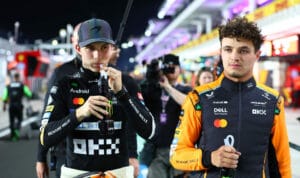The name still evokes memories of the glory days. When one sees the W of Williams on the nose of a Formula 1 car, they immediately think of founder Frank, and are transported back to the successful eighties and nineties.
During those years, Williams was a top team in F1. They excelled in victories, pole positions, and even titles. Whether the driver behind the wheel was Alan Jones, Nigel Mansell, Alain Prost, or Damon Hill, Frank Williams and technical chief Patrick Head knew how to provide them with championship cars, often designed by Adrian Newey.
For founder Frank Williams, the successful years were a godsend, as his team – and predecessor Frank Williams Racing Cars – had a rough start. It was only when the money tap with Saudi oil dollars started to support the team in 1978 that results began to improve. Williams then grew, later also becoming a top team product of its time, with extensive deals with tobacco sponsors and engine manufacturers. Off the track, however, it faced serious setbacks, with team boss Frank Williams becoming partially paralyzed in a traffic accident in 1986.
Ruling with Renault
Even confined to his wheelchair, the tough Brit did not let himself be slowed down. Williams’ best years were yet to come, together with Renault from 1989 to 1997. The Franco-British combination was good for no less than five constructors’ titles and four times the crown for the drivers during that period. The pinnacle was undoubtedly 1992, when Mansell dominated the title in one of the most iconic Formula 1 cars ever: the highly advanced FW14B.
The Triumphs and Tragedies of Williams
Despite all its triumphs, Williams also experienced further tragedy: in 1994, the illustrious Ayrton Senna died in a crash at Imola in his Williams. Senna had been Williams’ most formidable F1 rival with McLaren in the previous years, but had finally joined the team in 1994. Highly coveted by Frank Williams, it seemed like a dream combination: the best driver with the best team. Unfortunately, that dark afternoon at Imola turned it into a nightmare.
With first Damon Hill and then Jacques Villeneuve as new helmsmen, the ‘double’ of the drivers’ and constructors’ title was still achieved in 1996 and 1997. With a total of nine constructors’ crowns and seven drivers’ championships, Williams can still be considered one of the most successful teams in F1 history, despite the decline that began in late 1997 with the break with Renault and the departure of design genius Adrian Newey.
The Decline
There is no doubt that things started to go downhill after 1997. The dreamed partnership with BMW (2000-2005) was never more than an uncomfortable marriage of convenience. A brief resurgence at the beginning of the hybrid era, mainly driven by the ultra-powerful Mercedes engines in the cars, could not hide the fact that the foundation for F1 success had been knocked out from under the traditional team. In the following years, it became clear that Williams had been overtaken by time, mainly living off past glory.
Instead of top drivers, the team increasingly attracted passers-by. Mainly because of their sponsorship money or connections, less appealing names like Pastor Maldonado, Lance Stroll, Sergej Sirotkin, and Nicholas Latifi followed in the footsteps of the Prosts and Mansells of yesteryear (or the Ralf Schumachers and Juan Pablo Montoyas of later years). Speaking of names: the team from Grove still proudly bears the Williams family name, but is no longer a family team. In the summer of 2020, investment fund Dorilton Capital bought the team.
“We had no choice. Williams is no longer a family team, but at least it can continue to exist – with prospects for the future,” explained Claire Williams, who had been in charge of day-to-day operations for several years. Her father Frank stepped back around 2010, 2011, but remained involved. Even after the sale to Dorilton, he saw the first tentative signs of recovery, until his death in 2021. The founder of the once illustrious team may no longer be with us, but his name and legacy live on. Just look at the iconic W on the nose of every car that still bears his initials: FW. Now to revive the glory days…
Revival
After several lean years, the upward trend seems to have been cautiously set with former Mercedes strategist James Vowles at the helm. The team is no longer the ugly duckling of the F1 grid and regularly shows itself in the midfield. Even a few points are fought for by Alex Albon. The former Red Bull driver is thriving at Williams and showing that he can really steer. Rookie Logan Sargeant, however, is making less of an impression this season, and it remains to be seen whether we will see him again in 2024.
Williams F1 Team Overview
The Williams F1 team, a stalwart in the world of Formula 1 racing, has a rich history and a promising future. Here’s a snapshot of the team’s key personnel and achievements.
| Team Principal | James Vowles |
| Technical Director | Pat Fry |
| Chief Engineer | Dave Robson |
| Test Drivers 2023 | – |
| Headquarters | Grove, England |
| F1 Debut | Argentinian Grand Prix, 1975 |
| Drivers’ Championships | 7 (1980, 1982, 1987, 1992, 1993, 1996, 1997) |
| Constructors’ Championships | 9 (1980, 1981, 1986, 1987, 1992, 1993, 1994, 1996, 1997) |
| Final Standings 2023 | 7 |
Williams F1 Drivers
The team’s current drivers, Alexander Albon and Logan Sargeant, bring a mix of experience and youthful energy to the track.
| Alexander Albon #23 | |
| Nationality | Thai |
| Birthdate | March 23, 1996 |
| F1 Debut | Australia, 2019 |
| World Championships | 0 |
| Final Standings 2023 | 13 |
| Logan Sargeant #2 | |
| Nationality | American |
| Birthdate | December 31, 2000 |
| F1 Debut | Bahrain, 2023 |
| World Championships | 0 |
| Final Standings 2023 | 21 |
Alex Albon’s Remarkable Overtake at Silverstone
One of the highlights of the season was undoubtedly Alex Albon’s impressive overtaking maneuver at the Silverstone circuit. This moment showcased the driver’s skill and determination, further solidifying his place in the team.







